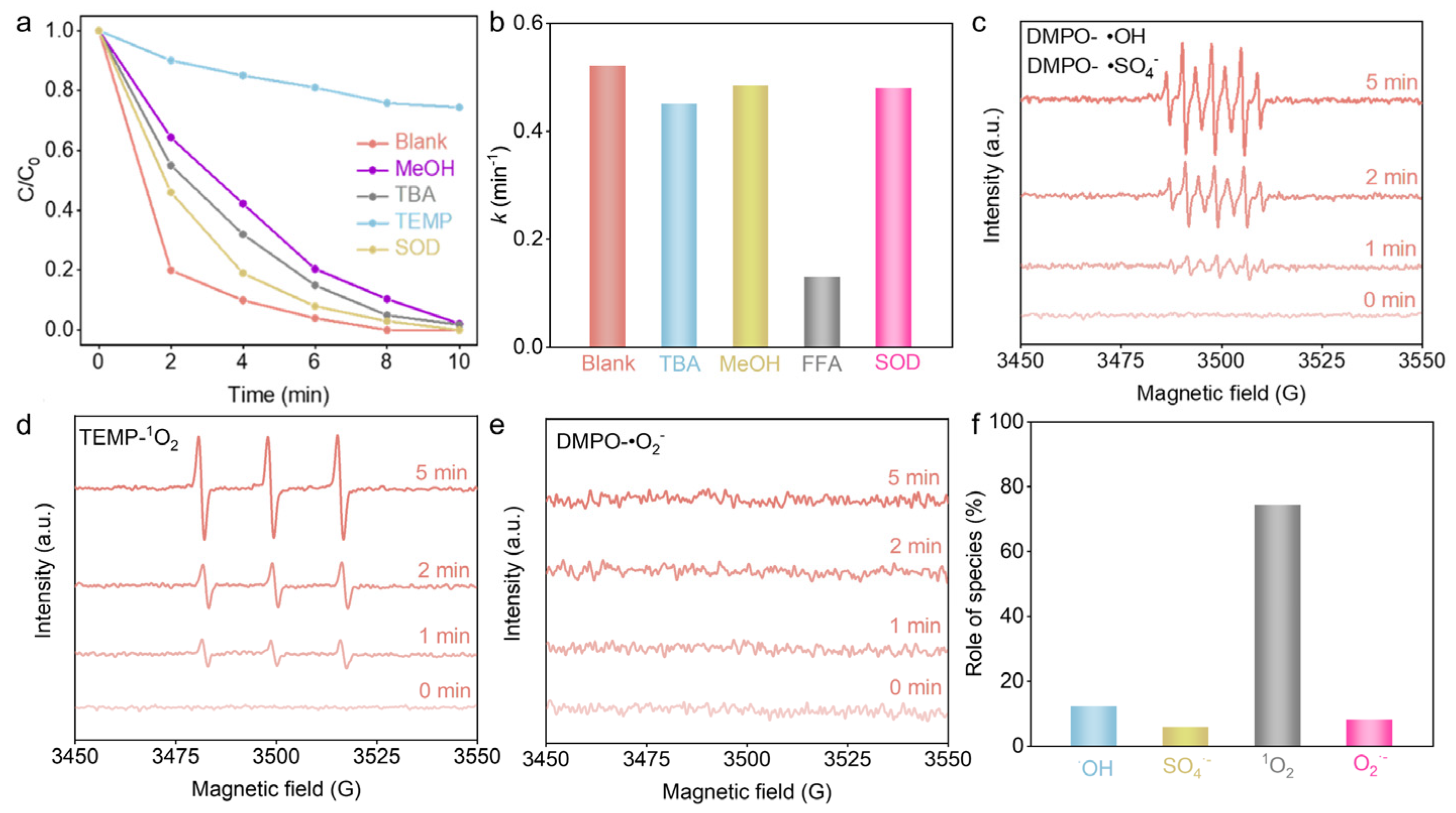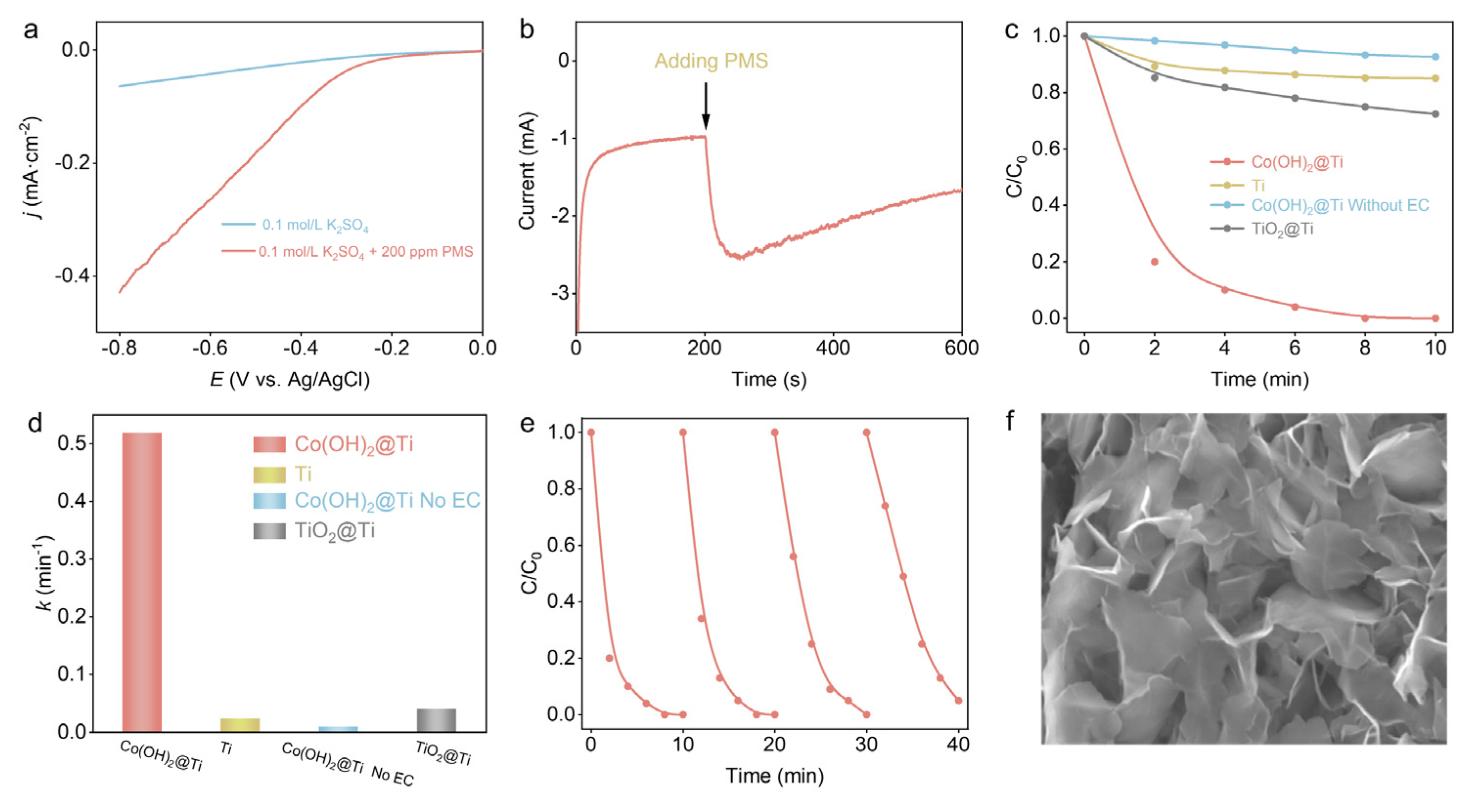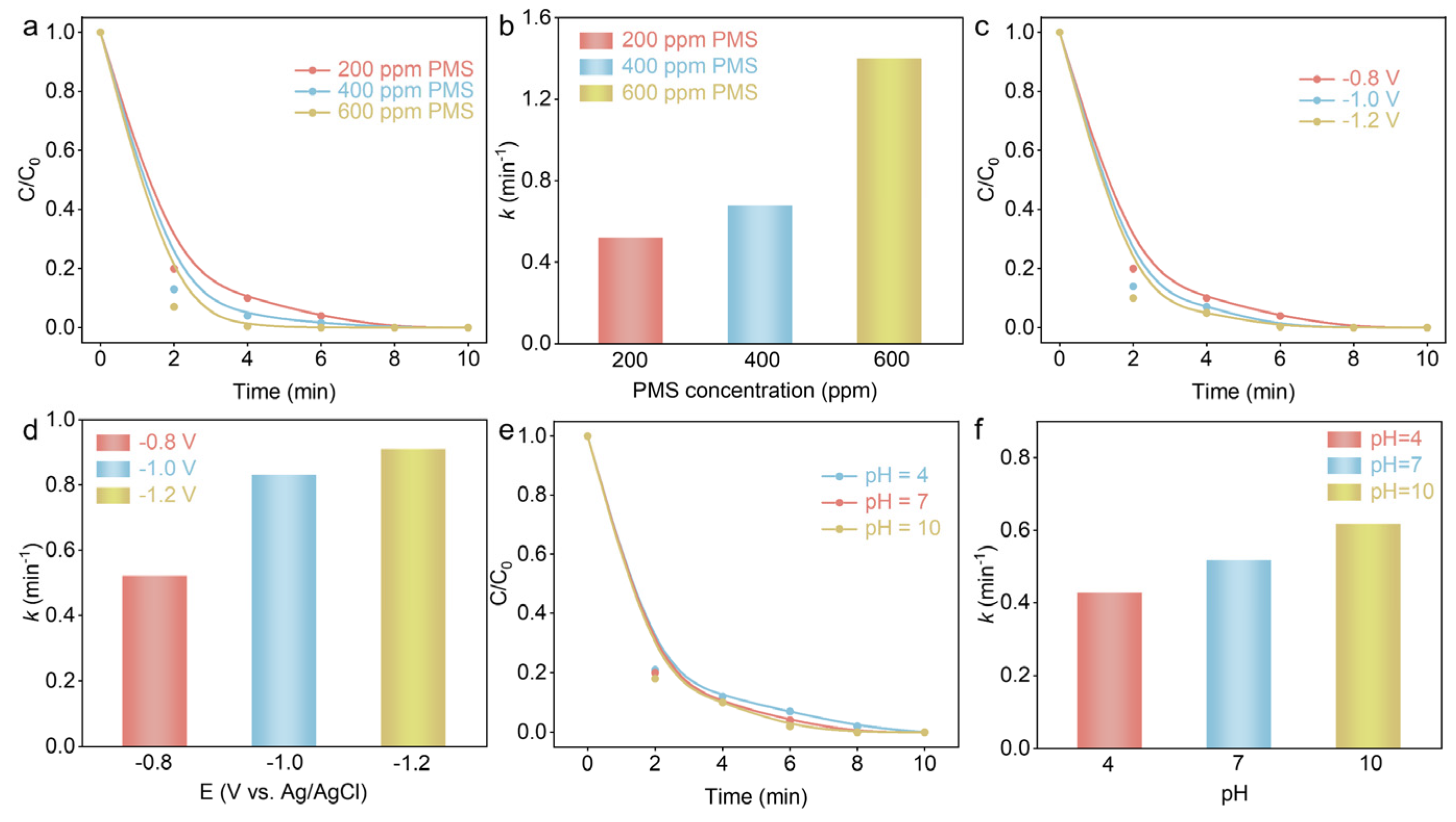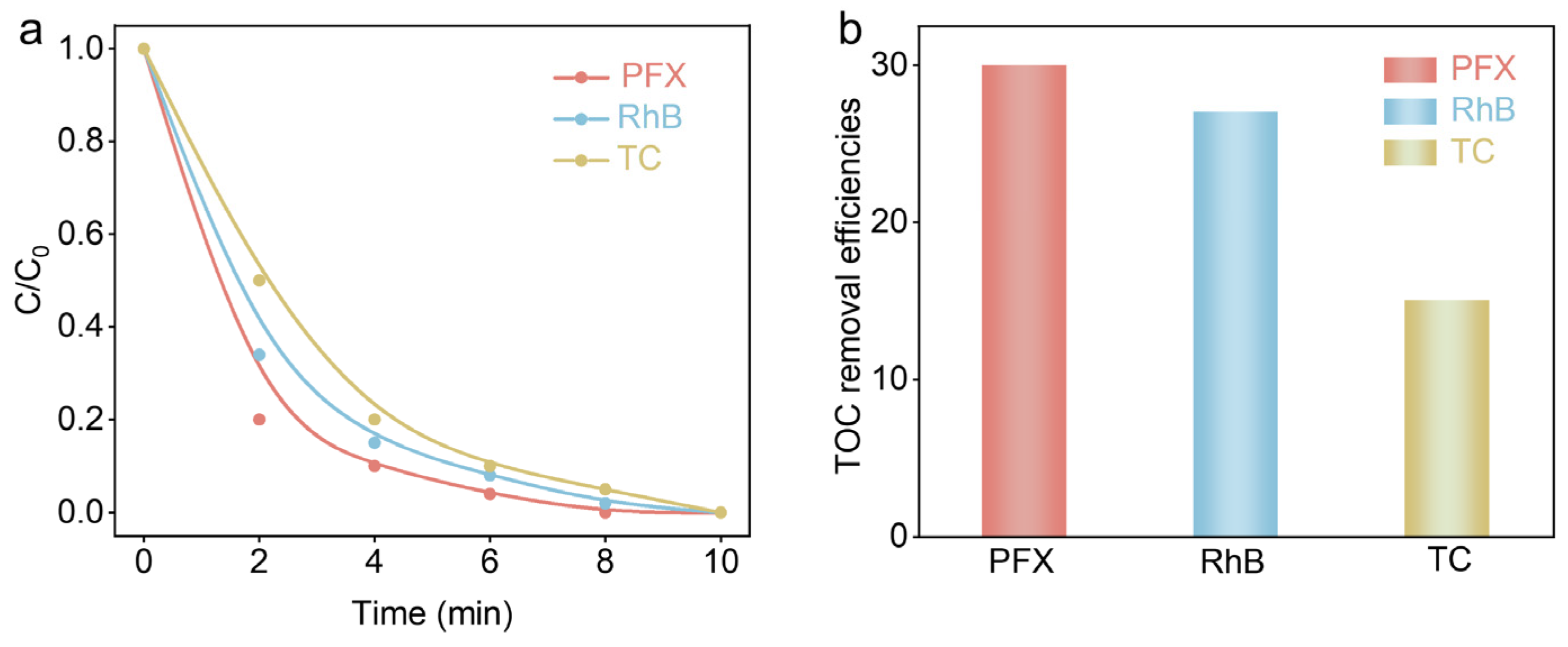Highly Efficient Peroxymonosulfate Electroactivation on Co(OH)2 Nanoarray Electrode for Pefloxacin Degradation
Abstract
:1. Introduction
2. Materials and Methods
2.1. Preparation of Co(OH)2@Ti Nanoarray Electrode
2.2. Experimental Setups
2.3. Analytical Methods
3. Discussion
3.1. Characterization of Catalytic Electrodes
3.2. Degradation of PFX in Co(OH)2@Ti/EA-PMS Process
3.3. The Mechanism of PFX Degradation in Co(OH)2@Ti/EA-PMS Process

4. Conclusions
Supplementary Materials
Author Contributions
Funding
Data Availability Statement
Conflicts of Interest
References
- Yao, B.; Zeng, W.; Núñez-Delgado, A.; Zhou, Y. Simultaneous adsorption of ciprofloxacin and Cu2+ using Fe and N co-doped biochar: Competition and selective separation. Waste Manag. 2023, 168, 386–395. [Google Scholar] [CrossRef]
- Zhang, Y.; Hu, Y.; Li, X.; Gao, L.; Wang, S.; Jia, S.; Shi, P.; Li, A. Prevalence of antibiotics, antibiotic resistance genes, and their associations in municipal wastewater treatment plants along the Yangtze River basin, China. Environ. Pollut. 2024, 348, 123800. [Google Scholar] [CrossRef]
- Zhou, Y.; Wang, J. Electro-Fenton degradation of pefloxacin using MOFs derived Cu, N co-doped carbon as a nanocomposite catalyst. Environ. Pollut. 2024, 355, 124198. [Google Scholar] [CrossRef]
- Liu, D.; Xue, X.; Zhang, X.; Huang, Y.; Feng, P. Highly efficient peroxymonosulfate activation by MOFs-derived oxygen vacancy-rich Co3O4/ZnO p-n heterojunction nanocomposites to degrade pefloxacin. Sep. Purif. Technol. 2023, 305, 122451. [Google Scholar] [CrossRef]
- Li, M.; Jia, L.; Chen, X.; Li, Y.; Zhao, D.; Zhang, L.; Zhao, T.; Xu, J. Web system-assisted ratiometric fluorescent probe embedded with machine learning for intelligent detection of pefloxacin. Sens. Actuators B Chem. 2024, 407, 135491. [Google Scholar] [CrossRef]
- Wang, J.; Chu, L.; Wojnárovits, L.; Takács, E. Occurrence and fate of antibiotics, antibiotic resistant genes (ARGs) and antibiotic resistant bacteria (ARB) in municipal wastewater treatment plant: An overview. Sci. Total Environ. 2020, 744, 140997. [Google Scholar] [CrossRef]
- Yao, B.; Qin, T.; Zhao, C.; Zhou, Y. Degradation of sulfanilamide in aqueous solution by ionizing radiation: Performance and mechanism. Environ. Pollut. 2023, 338, 122681. [Google Scholar] [CrossRef]
- Huang, X.; Wen, D.; Wang, J. Radiation-induced degradation of sulfonamide and quinolone antibiotics: A brief review. Radiat. Phys. Chem. 2024, 215, 111373. [Google Scholar] [CrossRef]
- Zhuang, S.; Wang, J. Adsorptive removal of pharmaceutical pollutants by defective metal organic framework UiO-66: Insight into the contribution of defects. Chemosphere 2021, 281, 130997. [Google Scholar] [CrossRef]
- Ghanbari, F.; Moradi, M. Application of peroxymonosulfate and its activation methods for degradation of environmental organic pollutants: Review. Chem. Eng. J. 2017, 310, 41–62. [Google Scholar] [CrossRef]
- Oh, W.-D.; Dong, Z.; Lim, T.-T. Generation of sulfate radical through heterogeneous catalysis for organic contaminants removal: Current development, challenges and prospects. Appl. Catal. B 2016, 194, 169–201. [Google Scholar] [CrossRef]
- Abdelrahman, A.; Ganiyu, S.O.; Gamal El-Din, M. Degradation of surrogate and real naphthenic acids from simulated and real oil sands process water using electrochemically activated peroxymonosulfate (EO-PMS) process. Sep. Purif. Technol. 2023, 306, 122462. [Google Scholar] [CrossRef]
- Li, S.; Zhou, M.; Wu, H.; Song, G.; Jing, J.; Meng, N.; Wang, W. High-efficiency degradation of carbamazepine by the synergistic electro-activation and bimetals (FeCo@NC) catalytic-activation of peroxymonosulfate. Appl. Catal. B 2023, 338, 123064. [Google Scholar] [CrossRef]
- Yu, S.; Zhang, Q.; Sun, X.; Chen, S.; Tang, J.; Zhu, J.-J.; Dang, Y. Doping Sb into CuFe2O4 improved the catalytic performance in the electrochemically enhanced homogeneous peroxymonosulfate-heterogeneous catalytic system for the degradation of ciprofloxacin. J. Environ. Chem. Eng. 2022, 10, 108335. [Google Scholar] [CrossRef]
- Wang, H.; Liu, H.; Chu, Z.; Sun, F.; Zou, X.; Wang, Q.; Chen, T.; Chen, D.; Wang, H. Fe3O4 derived from the decomposition of siderite as a heterogeneous photocatalyst to degrade 2,4-dichlorophenol via activating PMS. J. Water Process Eng. 2024, 57, 104538. [Google Scholar] [CrossRef]
- Li, J.; Xu, M.; Yao, G.; Lai, B. Enhancement of the degradation of atrazine through CoFe2O4 activated peroxymonosulfate (PMS) process: Kinetic, degradation intermediates, and toxicity evaluation. Chem. Eng. J. 2018, 348, 1012–1024. [Google Scholar] [CrossRef]
- Gerken, J.B.; McAlpin, J.G.; Chen, J.Y.C.; Rigsby, M.L.; Casey, W.H.; Britt, R.D.; Stahl, S.S. Electrochemical Water Oxidation with Cobalt-Based Electrocatalysts from pH 0–14: The Thermodynamic Basis for Catalyst Structure, Stability, and Activity. J. Am. Chem. Soc. 2011, 133, 14431–14442. [Google Scholar] [CrossRef]
- Li, B.; Wang, Y.-F.; Zhang, L.; Xu, H.-Y. Enhancement strategies for efficient activation of persulfate by heterogeneous cobalt-containing catalysts: A review. Chemosphere 2022, 291, 132954. [Google Scholar] [CrossRef]
- Wang, J.; Wang, S. Activation of persulfate (PS) and peroxymonosulfate (PMS) and application for the degradation of emerging contaminants. Chem. Eng. J. 2018, 334, 1502–1517. [Google Scholar] [CrossRef]
- Quan, X.; Zhang, J.; Yin, L.; Zuo, W.; Tian, Y. Fe3O4 decorated with α-cyclodextrin for enhanced peroxymonosulfate(PMS)-activated degradation of PPCPs. Sep. Purif. Technol. 2023, 317, 123904. [Google Scholar] [CrossRef]
- Zhou, Z.; Liu, T.; Wu, J.; Li, H.; Chu, S.; Zhu, X.; Zhang, L.; Lu, J.; Ivanets, A.; Davronbek, B.; et al. Preparation of copper-based catalysts from electroplating sludge by ultrasound treatment and their antibiotic degradation performance. Environ. Res. 2023, 216, 114567. [Google Scholar] [CrossRef] [PubMed]
- Chen, L.; Ding, D.; Liu, C.; Cai, H.; Qu, Y.; Yang, S.; Gao, Y.; Cai, T. Degradation of norfloxacin by CoFe2O4-GO composite coupled with peroxymonosulfate: A comparative study and mechanistic consideration. Chem. Eng. J. 2018, 334, 273–284. [Google Scholar] [CrossRef]
- Dong, P.; Chen, X.; Guo, M.; Wu, Z.; Wang, H.; Lin, F.; Zhang, J.; Wang, S.; Zhao, C.; Sun, H. Heterogeneous electro-Fenton catalysis with self-supporting CFP@MnO2-Fe3O4/C cathode for shale gas fracturing flowback wastewater. J. Hazard. Mater. 2021, 412, 125208. [Google Scholar] [CrossRef]
- Yu, F.; Guo, Y.; Li, H.; Yang, J. Activated persulfate by the synergistic electro-activation and bimetals cathode (MBC@CF) leads to highly efficient degradation of tetracycline. Sep. Purif. Technol. 2024, 335, 126204. [Google Scholar] [CrossRef]
- Ganiyu, S.O.; Hussain, N.A.S.; Stafford, J.L.; Gamal El-Din, M. Electrocatalytic activation of peroxomonosulfate (PMS) under aerobic condition for the remediation of oil sands process water: Insight into one-pot synergistic coupling of PMS electro-activation and heterogeneous electro-Fenton processes. Chem. Eng. J. 2024, 480, 147737. [Google Scholar] [CrossRef]
- Yu, C.; Zhao, Z.; Zong, Y.; Xu, L.; Zhang, B.; Wu, D. Electric field-enhanced coupled with metal-free peroxymonosulfate activactor: The selective oxidation of nonradical species-dominated system. Water Res. 2022, 227, 119323. [Google Scholar] [CrossRef]
- Di, J.; Zhu, M.; Jamakanga, R.; Gai, X.; Li, Y.; Yang, R. Electrochemical activation combined with advanced oxidation on NiCo2O4 nanoarray electrode for decomposition of Rhodamine B. J. Water Process Eng. 2020, 37, 101386. [Google Scholar] [CrossRef]
- Zhang, M.; Gong, Y.; Ma, N.; Zhao, X. Promoted photoelectrocatalytic degradation of BPA with peroxymonosulfate on a MnFe2O4 modified carbon paper cathode. Chem. Eng. J. 2020, 399, 125088. [Google Scholar] [CrossRef]
- Lv, S.; Xia, G.; Jin, C.; Hao, C.; Wang, L.; Li, J.; Zhang, Y.; Zhu, J.J. Low-temperature CO oxidation by Co3O4 nanocubes on the surface of Co(OH)2 nanosheets. Catal. Commun. 2016, 86, 100–103. [Google Scholar] [CrossRef]
- Xie, D.; Chu, S.; Zhang, S.; Ivanets, A.; Zhang, L.; Su, X. Facile synthesis of Cr-doped ferrite catalyst from Cr-containing electroplating sludge with activated persulfate for efficient degradation of tetracycline. J. Environ. Chem. Eng. 2022, 10, 108805. [Google Scholar] [CrossRef]
- Zhou, Z.; Zhang, L.; Yan, B.; Wu, J.; Kong, D.; Romanovski, V.; Ivanets, A.; Li, H.; Chu, S.; Su, X. Removal of chromium from electroplating sludge by roasting-acid leaching and catalytic degradation of antibiotics by its residue. J. Environ. Chem. Eng. 2024, 12, 111754. [Google Scholar] [CrossRef]
- Cheng, X.; Guo, H.; Zhang, Y.; Wu, X.; Liu, Y. Non-photochemical production of singlet oxygen via activation of persulfate by carbon nanotubes. Water Res. 2017, 113, 80–88. [Google Scholar] [CrossRef] [PubMed]
- Borgstahl, G.E.O.; Oberley-Deegan, R.E. Superoxide Dismutases (SODs) and SOD Mimetics. Antioxidants 2018, 7, 156. [Google Scholar] [CrossRef] [PubMed]
- Tan, C.; Gao, N.; Deng, Y.; Deng, J.; Zhou, S.; Li, J.; Xin, X. Radical induced degradation of acetaminophen with Fe3O4 magnetic nanoparticles as heterogeneous activator of peroxymonosulfate. J. Hazard. Mater. 2014, 276, 452–460. [Google Scholar] [CrossRef] [PubMed]
- Lang, Y.; Wu, S.; Yang, Q.; Luo, Y.; Jiang, X.; Wu, P. Analysis of the Isotopic Purity of D2O with the Characteristic NIR-II Phosphorescence of Singlet Oxygen from a Photostable Polythiophene Photosensitizer. Anal. Chem. 2021, 93, 9737–9743. [Google Scholar] [CrossRef] [PubMed]
- Guan, C.; Jiang, J.; Pang, S.; Chen, X.; Webster, R.D.; Lim, T.-T. Facile synthesis of pure g-C3N4 materials for peroxymonosulfate activation to degrade bisphenol A: Effects of precursors and annealing ambience on catalytic oxidation. Chem. Eng. J. 2020, 387, 123726. [Google Scholar] [CrossRef]
- Żamojć, K.; Zdrowowicz, M.; Rudnicki-Velasquez, P.B.; Krzymiński, K.; Zaborowski, B.; Niedziałkowski, P.; Jacewicz, D.; Chmurzyński, L. The development of 1,3-diphenylisobenzofuran as a highly selective probe for the detection and quantitative determination of hydrogen peroxide. Free Radic. Res. 2017, 51, 38–46. [Google Scholar] [CrossRef] [PubMed]
- Joo, S.H.; Feitz, A.J.; Sedlak, D.L.; Waite, T.D. Quantification of the Oxidizing Capacity of Nanoparticulate Zero-Valent Iron. Environ. Sci. Technol. 2005, 39, 1263–1268. [Google Scholar] [CrossRef] [PubMed]
- Žerjav, G.; Albreht, A.; Vovk, I.; Pintar, A. Revisiting terephthalic acid and coumarin as probes for photoluminescent determination of hydroxyl radical formation rate in heterogeneous photocatalysis. Appl. Catal. A 2020, 598, 117566. [Google Scholar] [CrossRef]
- Fu, Y.; Li, Z.; Liu, Q.; Yang, X.; Tang, H. Construction of carbon nitride and MoS2 quantum dot 2D/0D hybrid photocatalyst: Direct Z-scheme mechanism for improved photocatalytic activity. Chin. J. Catal. 2017, 38, 2160–2170. [Google Scholar] [CrossRef]
- Li, K.; Zhao, B.; Bai, J.; Ma, H.; Fang, Z.; Zhu, X.; Sun, Y. A High-Energy-Density Hybrid Supercapacitor with P-Ni(OH)2@Co(OH)2 Core–Shell Heterostructure and Fe2O3 Nanoneedle Arrays as Advanced Integrated Electrodes. Small 2020, 16, 2001974. [Google Scholar] [CrossRef] [PubMed]
- Wang, J.; Gao, R.; Zhou, D.; Chen, Z.; Wu, Z.; Schumacher, G.; Hu, Z.; Liu, X. Boosting the Electrocatalytic Activity of Co3O4 Nanosheets for a Li-O2 Battery through Modulating Inner Oxygen Vacancy and Exterior Co3+/Co2+ Ratio. ACS Catal. 2017, 7, 6533–6541. [Google Scholar] [CrossRef]
- Zhao, P.; Fu, S.; Luo, Y.; Peng, C.; Cheng, L.; Jiao, Z. Deciphering the Space Charge Effect of the CoNiLDH/FeOOH n–n Heterojunction for Efficient Electrocatalytic Oxygen Evolution. Small 2023, 19, 2305241. [Google Scholar] [CrossRef]
- Lan, D.; Gao, Z.; Zhao, Z.; Wu, G.; Kou, K.; Wu, H. Double-shell hollow glass microspheres@Co2SiO4 for lightweight and efficient electromagnetic wave absorption. Chem. Eng. J. 2021, 408, 127313. [Google Scholar] [CrossRef]
- Zhang, Y.; Hu, Y.; Wang, Z.; Lin, T.; Zhu, X.; Luo, B.; Hu, H.; Xing, W.; Yan, Z.; Wang, L. Lithiation-Induced Vacancy Engineering of Co3O4 with Improved Faradic Reactivity for High-Performance Supercapacitor. Adv. Funct. Mater. 2020, 30, 2004172. [Google Scholar] [CrossRef]
- Yan, M.; Zhao, Z.; Cui, P.; Mao, K.; Chen, C.; Wang, X.; Wu, Q.; Yang, H.; Yang, L.; Hu, Z. Construction of hierarchical FeNi3@(Fe,Ni)S2 core-shell heterojunctions for advanced oxygen evolution. Nano Res. 2021, 14, 4220–4226. [Google Scholar] [CrossRef]
- Yan, M.; Mao, K.; Cui, P.; Chen, C.; Zhao, J.; Wang, X.; Yang, L.; Yang, H.; Wu, Q.; Hu, Z. In situ construction of porous hierarchical (Ni3-xFex)FeN/Ni heterojunctions toward efficient electrocatalytic oxygen evolution. Nano Res. 2020, 13, 328–334. [Google Scholar] [CrossRef]
- Zhang, Z.; Zhan, X.; Hong, B.; Wang, X.; Tang, P.; Ding, Y.; Xia, Y.; Zeng, Y. Edge interface microenvironment regulation of CoOOH/commercial activated carbon nano-hybrids enabling PMS activation for degrading ciprofloxacin. J. Colloid Interface Sci. 2024, 663, 909–918. [Google Scholar] [CrossRef] [PubMed]
- Dong, S.; Yang, S.; Chen, Y.; Kuss, C.; Cui, G.; Johnson, L.R.; Gao, X.; Bruce, P.G. Singlet oxygen and dioxygen bond cleavage in the aprotic lithium-oxygen battery. Joule 2022, 6, 185–192. [Google Scholar] [CrossRef]
- Li, W.; Li, W.; He, K.; Tang, L.; Liu, Q.; Yang, K.; Chen, Y.-D.; Zhao, X.; Wang, K.; Lin, H.; et al. Peroxymonosulfate activation by oxygen vacancies-enriched MXene nano-Co3O4 co-catalyst for efficient degradation of refractory organic matter: Efficiency, mechanism, and stability. J. Hazard. Mater. 2022, 432, 128719. [Google Scholar] [CrossRef]
- Xu, P.; Wang, P.; Li, X.; Wei, R.; Wang, X.; Yang, C.; Shen, T.; Zheng, T.; Zhang, G. Efficient peroxymonosulfate activation by CuO-Fe2O3/MXene composite for atrazine degradation: Performance, coexisting matter influence and mechanism. Chem. Eng. J. 2022, 440, 135863. [Google Scholar] [CrossRef]
- Song, H.; Du, R.; Wang, Y.; Zu, D.; Zhou, R.; Cai, Y.; Wang, F.; Li, Z.; Shen, Y.; Li, C. Anchoring single atom cobalt on two-dimensional MXene for activation of peroxymonosulfate. Appl. Catal. B 2021, 286, 119898. [Google Scholar] [CrossRef]
- Guo, L.; Zhao, J.; Zhao, L.; Tang, Y.; Zhou, J.; Shi, B. Persulfate activation by Cr2O3/BC derived from chrome shavings for antibiotics degradation. Chem. Eng. J. 2021, 420, 127698. [Google Scholar] [CrossRef]





Disclaimer/Publisher’s Note: The statements, opinions and data contained in all publications are solely those of the individual author(s) and contributor(s) and not of MDPI and/or the editor(s). MDPI and/or the editor(s) disclaim responsibility for any injury to people or property resulting from any ideas, methods, instructions or products referred to in the content. |
© 2024 by the authors. Licensee MDPI, Basel, Switzerland. This article is an open access article distributed under the terms and conditions of the Creative Commons Attribution (CC BY) license (https://creativecommons.org/licenses/by/4.0/).
Share and Cite
Bao, T.; Ke, H.; Li, W.; Cai, L.; Huang, Y. Highly Efficient Peroxymonosulfate Electroactivation on Co(OH)2 Nanoarray Electrode for Pefloxacin Degradation. Nanomaterials 2024, 14, 1312. https://doi.org/10.3390/nano14151312
Bao T, Ke H, Li W, Cai L, Huang Y. Highly Efficient Peroxymonosulfate Electroactivation on Co(OH)2 Nanoarray Electrode for Pefloxacin Degradation. Nanomaterials. 2024; 14(15):1312. https://doi.org/10.3390/nano14151312
Chicago/Turabian StyleBao, Tonghui, Hui Ke, Wanjiang Li, Linke Cai, and Yi Huang. 2024. "Highly Efficient Peroxymonosulfate Electroactivation on Co(OH)2 Nanoarray Electrode for Pefloxacin Degradation" Nanomaterials 14, no. 15: 1312. https://doi.org/10.3390/nano14151312




